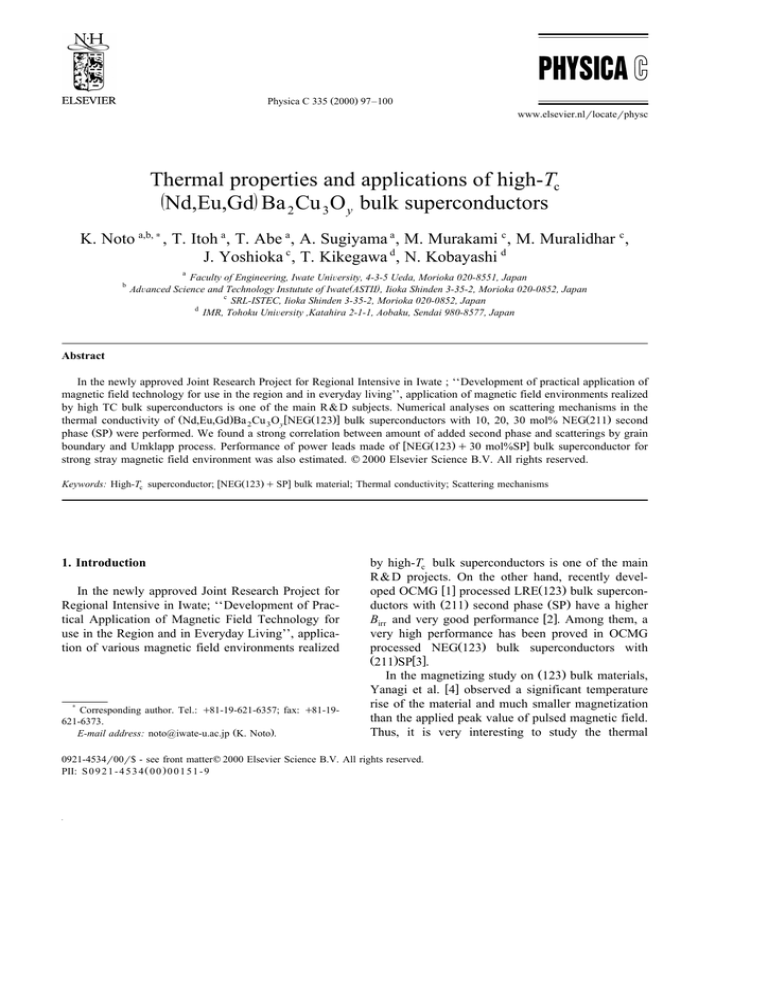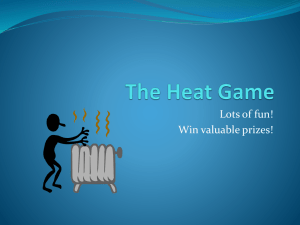T Nd,Eu,Gd Ba Cu O bulk superconductors ž /
advertisement

Physica C 335 Ž2000. 97–100 www.elsevier.nlrlocaterphysc Thermal properties and applications of high-Tc žNd,Eu,Gd/ Ba 2 Cu 3 O y bulk superconductors K. Noto a,b,) , T. Itoh a , T. Abe a , A. Sugiyama a , M. Murakami c , M. Muralidhar c , J. Yoshioka c , T. Kikegawa d , N. Kobayashi d b a Faculty of Engineering, Iwate UniÕersity, 4-3-5 Ueda, Morioka 020-8551, Japan AdÕanced Science and Technology Instutute of Iwate(ASTII), Iioka Shinden 3-35-2, Morioka 020-0852, Japan c SRL-ISTEC, Iioka Shinden 3-35-2, Morioka 020-0852, Japan d IMR, Tohoku UniÕersity ,Katahira 2-1-1, Aobaku, Sendai 980-8577, Japan Abstract In the newly approved Joint Research Project for Regional Intensive in Iwate ; ‘‘Development of practical application of magnetic field technology for use in the region and in everyday living’’, application of magnetic field environments realized by high TC bulk superconductors is one of the main R & D subjects. Numerical analyses on scattering mechanisms in the thermal conductivity of ŽNd,Eu,Gd.Ba 2 Cu 3 O y wNEGŽ123.x bulk superconductors with 10, 20, 30 mol% NEGŽ211. second phase ŽSP. were performed. We found a strong correlation between amount of added second phase and scatterings by grain boundary and Umklapp process. Performance of power leads made of wNEGŽ123. q 30 mol%SPx bulk superconductor for strong stray magnetic field environment was also estimated. q 2000 Elsevier Science B.V. All rights reserved. Keywords: High-Tc superconductor; wNEGŽ123. q SPx bulk material; Thermal conductivity; Scattering mechanisms 1. Introduction In the newly approved Joint Research Project for Regional Intensive in Iwate; ‘‘Development of Practical Application of Magnetic Field Technology for use in the Region and in Everyday Living’’, application of various magnetic field environments realized ) Corresponding author. Tel.: q81-19-621-6357; fax: q81-19621-6373. E-mail address: noto@iwate-u.ac.jp ŽK. Noto.. by high-Tc bulk superconductors is one of the main R & D projects. On the other hand, recently developed OCMG w1x processed LREŽ123. bulk superconductors with Ž211. second phase ŽSP. have a higher Birr and very good performance w2x. Among them, a very high performance has been proved in OCMG processed NEGŽ123. bulk superconductors with Ž211.SPw3x. In the magnetizing study on Ž123. bulk materials, Yanagi et al. w4x observed a significant temperature rise of the material and much smaller magnetization than the applied peak value of pulsed magnetic field. Thus, it is very interesting to study the thermal 0921-4534r00r$ - see front matterq 2000 Elsevier Science B.V. All rights reserved. PII: S 0 9 2 1 - 4 5 3 4 Ž 0 0 . 0 0 1 5 1 - 9 K. Noto et al.r Physica C 335 (2000) 97–100 98 Table 1 Amount of second phase ŽSP. in prepared NEGŽ123. bulk samples Sample Composition Ž P O 2 s 0.1%. Pt Žmol%. SP10 SP20 SP30 ŽNd,Eu,Gd.123q10 mol% SP ŽNd,Eu,Gd.123q20 mol% SP ŽNd,Eu,Gd.123q30 mol% SP 0.5 0.5 0.5 properties and intercorrelation between thermal properties and added SP amount. We found a strong correlation between magnitude of thermal conductivity or average SP size and added SP amount in the previous work w5x. In this paper, we tried numerical analyses of scattering mechanisms in the thermal conductivity of NEGŽ123. bulk samples with 10, 20, 30 mol% SP by the Tewort–Wolkhausen theory. Characteristics as power leads are also estimated for the NEGŽ123. q SP30 mol% material using the thermal conductivity data and Jc value calculated from SQUID magnetization. fitting curves of numerical analysis performed this time. Thermal conductivity is divided into electronic part and phonon part, K s K e q K ph . Since the electrical resistivity at room temperature is larger than 0.048 V cm for all samples, the electronic part is negligibly small: less than 0.1% of the total thermal conductivity. Therefore, we tried numerical fitting of total conductivity to the phonon thermal conductivity expression by Tewordt and Wolkhausen w7x: k ph s AT 3 Samples of NEGŽ123. were prepared by OCMG process w3x, main parameters of which are shown in Table 1. A good stoichiometry was obtained by the OCMG process. NEGŽ211.SP was added as strong pinning centers. Nd:Eu:Gds 1:1:1 for both 123 matrix phase and SP. Added SP amount is 10, 20, 30 mol%. Moreover, 0.5 mol%Pt is also added to get fine dispersion of SP. Thermal conductivity was measured by a standard steady-state heat flow method using a fully automatic thermal property measuring system w6x. Jc Ž B . was calculated from the results of magnetization hysteresis measured by SQUID magnetometor using the following relation Žmodified Bean model.: Jc Ž B . s 20D M a Ž 1 y a . r Ž 3b . 4 Ž e x y 1. 2 tph Ž x . d x Ž 2. and 1 1 1 s tph q tphyb 1 q tphyUm 1 q tphysh 1 q tphyp tphye Ž 3. These expressions can be rewritten as, k ph s At 3 = 2. Experimental x 4e x urT H0 H0urT x4e x Že y 1.2 x 1 1 q Bx exp Ž y Q ratT c . q C Ž tx . 2 q D Ž tx . 4 q E w g Ž t , x , y . x d x, Ž 4. where parameter A corresponds to the scattering time of boundary scattering and B, C, D and E Ž 1. 3. Results and discussion Fig. 1 shows the temperature dependence of previously reported thermal conductivity data w5x and Fig. 1. The temperture dependence of thermal conductivity. K. Noto et al.r Physica C 335 (2000) 97–100 99 Table 2 Best-fitted parameters in Eq. Ž4. SP 10 SP 20 SP 30 A B C D E 55 000 31 000 17 500 200 400 700 25 10 45 1300 1500 1500 60 30 10 correspond to the strength of the Umklapp process, sheetlike-fault scattering, point-defect scattering and electron–phonon scattering, respectively. The bestfitted parameters are listed in Table 2 and best-fitted curves are also shown in Fig. 1. We can see fairly good fitting using parameters shown in Table 2. These parameters are plotted against the added SP amount in Fig. 2. One can see a strong correlation between boundary scattering or Umklapp process and the added SP amount. Judging from the scatter of thermal conductivity data, we think that we cannot discuss a distinct correlation to the other parameters. We think that the main part of the grain boundary scattering should be at the SP grain boundaries. Fig. 3 shows thermal conductivity integration,Q˙ s S T H k ŽT .dT for S s 1 cm2 , L s 10 cm from data L 4.2 for the sample with 30 mol% SP. Since there is almost no magnetic field dependence in the thermal conductivity for all samples w5x, and Jc P 5 = 10 4 Fig. 3. The temperature dependence of thermal conductivity integration. Arcm2 up to 2.5 T for SP30 mol% sample, we can estimate the specifications of power leads for relatively strong stray field environment for the SP30 mol% material as follows, Cross-section 2 mm2 Length 10 cm Upper and lower end temperature 80 K, 4.2 K Specific thermal losses at 4.2 K O 160 m WrA Operational current 1000 A Critical current density P 5 = 10 4 Arcm2 Stray field up to 2.5 T 4. Summary After numerical fitting analyses on the thermal conductivity data of NEGŽ123. q 10, 20, 30 mol% SP samples w5x by the Tewort–Wolkhausen theoryw7x, it turned out that: Fig. 2. SP amount dependence of fitted parameters. 1. we can get fairly good fitting using parameters shown in Table 2, 2. there is a strong correlation between boundary scattering or Umklapp process and the SP amount, and 100 K. Noto et al.r Physica C 335 (2000) 97–100 3. we think the main part of the grain boundary scattering should be at the SP grain boundaries. We estimated specifications of power leads for a strong stray field environment for the SP30 mol% material, in which thermal losses are less than 1r6 of the conventional power leads. Acknowledgements The authors would like to thank Mr.S.Fujinuma ŽIwate Univ.. for technical assistance. This work was partly supported by New Energy and Industrial Technology Development Organization ŽNEDO.. References w1x M. Murakami, Jpn. J. Appl. Phys. 33 Ž1994. 715. w2x M. Muralidhar, M.R. Koblischka, M. Murakami, Supercond. Sci. Technol. 12 Ž1999. 105. w3x M. Muralidhar, M.R. Koblischka, M. Murakami, Supercond. Sci. Technol. 11 Ž1999. 1349. w4x Y. Yanagi, Y. Itoh, M. Yoshikawa, T. Oka, A. Mase, T. Hosokawa, H. Ikuta, U. Mizutani, Adv. Supercond. 11 Ž1998. 717. w5x K. Noto, T. Itoh, A. Sugiyama, M. Murakami, M. Muralidhar, J. Yoshioka, T. Kikegawa, N. Kobayashi, in: Cryogenic Engineering 341999, to be published Žin Japanese.. w6x N. Hobara, M. Matsukawa, N. Matsuura, H. Fujishiro, K. Noto, Cryogenic Engineering 6881993, p. 28, Žin Japanese.. w7x L. Tewordt, T.H. Wolkhausen, Solid State Commun. 70 Ž1989. ¨ 839.




